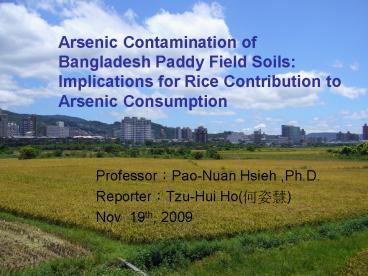Outlines - PowerPoint PPT Presentation
Title: Outlines
1
Arsenic Contamination of Bangladesh Paddy Field Soils Implications for Rice Contribution to Arsenic Consumption
ProfessorPao-Nuan Hsieh ,Ph.D. ReporterTzu-Hui Ho(???) Nov 19th, 2009
2
Outlines
- Abstract
- Introduction
- Materials and Methods
- Results and Discussion
- References
3
- ??????????(Smedley and kinniburgh, 2002)
- ??????????
- (Smedley and kinniburgh, 2002)
4
5
?????????????
6
Abstract
- Arsenic contaminated groundwater is used
extensively in Bangladesh to irrigate the staple
food of the region, paddy rice. - A survey of arsenic levels in paddy soils and
rice grain was undertaken. - Regression of soil arsenic levels with tube-well
age was significant.
7
Introduction(1/4)
- The digging of tube-wells for drinking water
supply into aquifers elevated in arsenic in
Bangladesh and West Bengal has been described as
the greatest mass poisoning in human history.
---36 million people exposed - Groundwater arsenic concentrations approaches 2mg
L-1, 200,000-270,000 people will die of cancer
from drinking arsenic contaminated drinking water
8
Introduction (2/4)
- Arsenic contaminated groundwater is not just used
for drinking water but is also widely used for
irrigation of crops,and particularly for the
staple food paddy rice,provides 73 of calorific
intake - Groundwater is used extensively to irrigate rice
crops in Bangladesh, particularly during the dry
season with 75 of the total cropped area given
over to rice cultivation and 83 of the total
irrigated area used for rice cultivation.
9
Introduction (3/4)
- Levels of arsenic in rice grain are typically
0.05-0.4 µg g-1 for North America, Europe, and
Taiwan(0.074 µg g-1 ). - Arsenic levels in rice grain reached 0.7 µg g-1
in rice grown on paddy soils containing 68 µg g-1
arsenic in China , showing the potential for
arsenic contamination of rice grain from
contaminated paddy soils.
10
Introduction (4/4)
- Contamination of soil was related to tube-well
arsenic levels, depth, and age to understand the
mechanism of soil contamination by arsenic. - Arsenic levels in Bangladesh produced rice, were
determined to calculate baseline exposure of the
population to rice derived arsenic. - Dietary arsenic exposure was then modeled using
these data.
11
Materials and Methods (1/3)
- Collection of Soil and Rice Grain SamplesSoil
and rice samples were collected during the period
of January-February, 2001. - Soil samples were collected from 27
administrative districts of Bangladesh, and a
total of 71 samples were obtained.
12
Materials and Methods (2/3)
- Analysis
- soil and rice grain(husk)?oven dry(70
ºC)?grinding - ?digested?nitric acid-hydrogen peroxide
- ?heating block(60 ºC)?cooled ?diluted in
deionized water - ?filtered(Whatman no. 42 filter paper)
- ?soil(Perkin-Elmer 3300)
- ?rice grain(Perkin-Elmer Aanalyst 300?FIAS
100 hydride generator)
13
Materials and Methods (3/3)
- Tube-Well Datayear constructed, depth, arsenic
levels obtain from the British Geological Survey
(BGS) web-site. - The BGS tube-well data was similarly averaged per
district for comparison with the soils data. - StatisticsMinitab v.13
14
Results and Discussion (1/9)
- Arsenic in Paddy Soils
- ?surface paddy soils 3.1 to 42.5 µg g-1
- ? the age and depth of the tube-wells need to
be - considered as arsenic will accumulate in
the - soil with long period of time
- ? the soils had become contaminated through
- irrigation with arsenic contaminated water
15
Results and Discussion (2/9)
well age vs arsenic levels(soil)
16
Results and Discussion (3/9)
- Continuous variable
- Two continuous variable ?covariance
- Linear regression
- Linear regression of tube-well age against paddy
soil arsenic levels was significant (P.048)lt.05 - Similar regressions with tube-well depth (P.505)
gt.05 and - tube-well arsenic levels (P .684) gt.05
were not significant
Regression equation
Scatter plot
17
Results and Discussion (4/9)
- tube-well depth and arsenic concentrations in the
well water were not significantly
well depth(m)25-50
Arsenic levels(GW)50-250
18
Results and Discussion (5/9)
- Arsenic Levels in Rice
- Samples collected from Gazipur District at the
Bangladesh Rice Research Institute had an average
level of - 0.092 µg g-1 dry wt,
- highest 0.21 µg g-1
Arsenic content 10.9,14.6 µg g-1
19
Results and Discussion (6/9)
- Western Bangladesh Districts arsenic levels
ranging from 0.058 to 1.83 µg g-1 - arsenic levels within the same range as the
- field trials at Gazipur
20
Results and Discussion (7/9)
- 113.5 mg?kg(as soil), 0.074 mg?kg(rice grain),at
Guandu,
21
Results and Discussion (8/9)
- calculate daily human intake of arsenic from
rice. - With a drinking water intake of 0.1 mg L-1,
arsenic intake from rice will account for 17.3
and 29.6 of arsenic consumption if rice
contained 0.1 and 0.2 µg g-1 of arsenic,
respectively. - These grain values are typical of what has been
observed in a range of studies in Asia, Europe,
and N. America
0.01
0.1
1
22
Results and Discussion (9/9)
- the bioavailability of arsenic in rice
- arsenic in rice grain ?inorganic arsenic?toxic
and readily assimilated into the blood stream - provide a safe water source
- decrease dietary exposure from arsenic still
exists.
23
References
- Meharg, A. A., and Rahman A. A., 2003.
Arsenic Contamination of Bangladesh Paddy Field
Soils Implications for Rice Contribution to
Arsenic Consumption, Environmental Science
Technnology, 37(2)229-334.
24
- Thanks for your attention!!

